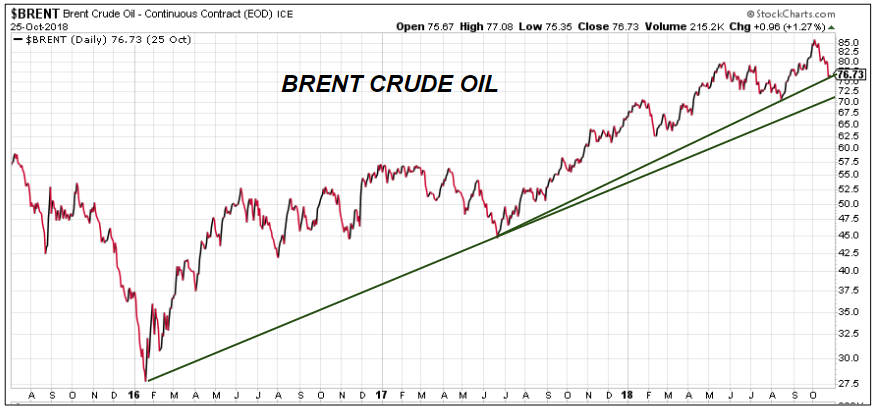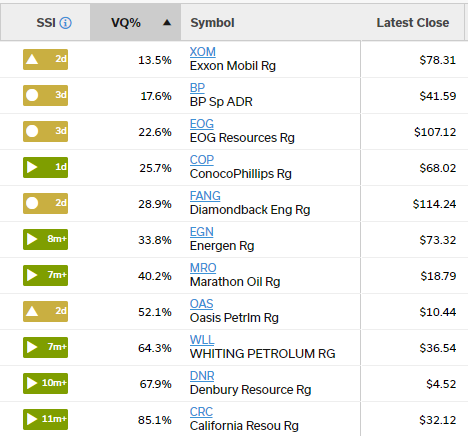Crude oil bottomed out nearly two years ago in January of 2016. From June 2017 onwards, the crude oil price has been in a rising bullish trend. We have been all over this trend since Day One.
There are two major benchmarks for the crude oil price, Brent and West Texas Intermediate (WTI). Brent is the international price benchmark, while WTI is focused on the continental United States. You can see the multi-year bullish trend in Brent crude via the chart below.

Crude oil prices have been falling lately, out of sympathy with rising stock market volatility. But it was just earlier this month that the Brent crude oil price touched a four-year high, after pushing higher for multiple weeks in a row.
There has been a steady drumbeat of rising bullishness around the crude oil price. A few weeks ago, the Wall Street Journal reported on call options data showing increased anticipation of oil rising above $100 a barrel.
As the WSJ reported, a research firm called QuikStrike looked at call options on crude oil futures with a January 2019 expiration and a $100 strike price. The number of call options contracts with that specific criteria has more than doubled since the beginning of September, suggesting a surge in confidence for the prospect of $100 oil.
At the same time, the number of call options at the $95 strike — also with January expiration — have more than quadrupled.
There are a handful of factors driving the bullish mood in oil right now. Two increasingly key drivers are looming sanctions on Iran and growing uncertainty around supply from OPEC (the Organization of Petroleum Exporting Countries). U.S. relations with Saudi Arabia are also an unknown.
The United States has imposed sanctions on Iran that take effect on Nov. 4. After that date, any company that buys crude oil from Iran risks being barred from the U.S. financial system — a harsh penalty that extends to all international dealings of U.S.-based banks.
This means a significant amount of crude oil output will effectively be “off the market,” as buyers for Iran’s crude will dry up. This has the same effect as shrinking the total crude oil supply, as the buyers of Iran’s crude who turn away will have to find other supply instead.
At the same time, it isn’t clear how easily Iran’s crude oil output can be replaced.
If the global crude oil market loses Iran’s 2.7 million barrels per day or a major portion of that, OPEC may not be able to make up the difference.
There is enough spare capacity on paper, but OPEC’s actual reserves are probably overstated. There are also significant supply threats, like recent terrorist attacks and sabotage attempts in Libya and Nigeria, and the inevitable challenges of ramping up capacity (which sometimes can’t be done due to equipment failure, aging fields, labor bottlenecks, and so on).
And then there is the Saudi Arabia question. U.S. relations with Saudi Arabia have been greatly complicated by the murder of Jamal Khashoggi, a Saudi journalist who had U.S. residence and was apparently abducted and killed on foreign soil.
U.S. congressional leaders are furious with Saudi Arabia, and the anger goes across the aisles. Republican Sen. Lindsey Graham has described Mohammed bin Salman, the Crown Prince of Saudi Arabia, as a “wrecking ball” who has “got to go.”
Meanwhile Republican and Democrat leaders of the Senate Committee on Foreign Relations have initiated a harsh sanctions bill against Saudi Arabia.
It isn’t clear that the White House wants to punish Saudi Arabia for the Khashoggi murder. They would rather keep relations smooth for bigger picture reasons. But the United States Congress has the ability to force the issue, and has the bipartisan will to do so, which means U.S.-Saudi relations could rapidly deteriorate in the coming weeks or months.
This creates another wild card for the oil price because Saudi Arabia’s spare production capacity is critical for filling the supply gap created by Iran oil sanctions.
If the Saudi leadership gets thin-skinned and decides to retaliate against U.S. sanctions — a real possibility — they could pull their spare production from a tightly supplied market, causing oil prices to skyrocket.
In the initial outrage and Saudi counter response to the Jamal Khashoggi incident, a Saudi government official openly threatened the use of oil as a weapon via the Saudi press, hyperbolically stating that “no one should rule out the price jumping to $100, or $200, or even double that figure.”
The fear of that possibility alone could push oil prices higher if U.S.-Saudi relations visibly deteriorate. And they seem to be on a collision course.
While there is scope for the price of oil to continue declining — as it has done for the past few weeks — it is also quite possible the bullish trend resumes — and under certain ugly scenarios as explained above, the crude oil price could not only go higher, but much, much higher.
This would be a positive for the oil majors and select oil and gas stocks, which have been a significant bright spot in a rocky market environment as of late.
The table below shows a cross section of energy, and oil and gas stocks with either green zone or yellow zone status — making them favorable plays if the bullish uptrend in oil resumes.

If the crude oil bull trend resumes — and there are a lot of factors favoring that occurrence — the probability rises that the yellow zone names in the above list will return to green SSI status.
That is a powerful entry point opportunity when it occurs, and it is also the basic idea behind our “Low Risk Runners” strategy in Ideas by TradeSmith.
You can find more selection methods like these in Ideas by TradeSmith, or by setting up and monitoring a watchlist in your own TradeStops portfolio.





